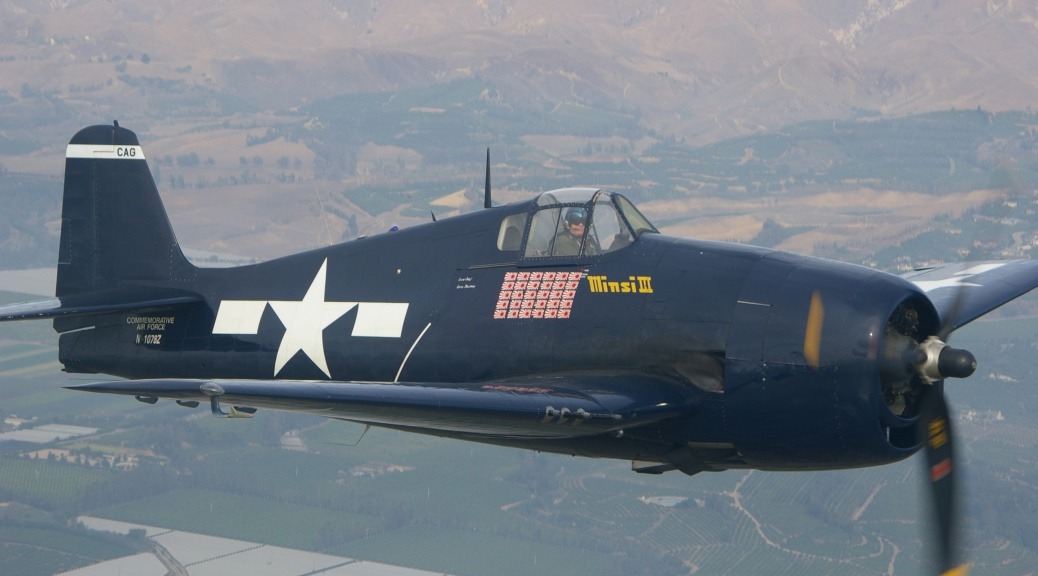F6F Hellcat was a highly successful follow-up to the Wildcat. Japanese Zero was quite a nuisance for the US Navy so it was built specifically to counter it. It worked almost perfectly and earned the nickname “ace maker.” Its obedient handling characteristics made it the Navy’s premier choice to be deployed with the Essex-class carriers. The Hellcat ruled the skies of the Western Pacific during 1943 and 1944.
The Hellcat was primarily designed for ease of manufacture and it had ample ability to withstand damage. With its “Aluminum Tank” resembling cockpit armor which was a total of 212 lb (96 kg), it was extremely tough, as well as a bullet-resistant windshield and armor around the engine oil tank and oil cooler complimented to its robustness. It had a self-sealing fuel tank that kept off any fire and the return back home safely was made possible.
Its cockpit was situated just above the low-mounted large wings and offered up sufficient visibility through a framed canopy. Engine was Pratt & Whitney R-2800 series radial piston engine which delivered 2,000 horsepower and provided speeds in excess of 375 miles per hour. Landing gear retracted in a backwards fashion.
F6F was equipped with 6 x 12.7mm (.50 caliber) heavy machine guns in pairs of threes to a wing with 400 rounds capability. Additionally air-to-surface explosive rockets (and conventional drop bombs could be attached if needed.
XF6F-3 prototype was selected to be the initial production model and featured the Pratt & Whitney R-2800-10 Double Wasp two-stage turbocharged engine. Shortly thereafter, production was switched to the refined F6F-5 model with the new Pratt & Whitney R-2800-10W radial piston engine.
It was first brought to use in January, 1943. With VF-9, the Hellcat was about to become the U.S. Navy’s most important fighter of World War II and it did achieve its feat. It was credited with nearly 75% of all naval air-to-air combat kills. It had incredibly strong airframe which helped it earn a kill-to-loss ratio of better than 19 to 1. Operational for only two years, it succeeded in shooting down a remarkable number of enemy aircraft. Out of a total of 6,477 enemy planes destroyed by carrier-based pilots, about 4,947 fell victim to Hellcats’ fire. Some 12,500 planes were produced. The only substantial wartime modification was the addition of a 150 gallon drop fuel tank to extend its range that proves its success story.
| Crew: | 1 |
| Length: | 33 ft 7 in (10.24 m) |
| Wingspan: | 42 ft 10 in (13.06 m) |
| Height: | 13 ft 1 in (3.99 m) |
| Wing area: | 334 ft² (31 m²) |
| Empty weight: | 9,238 lb (4,190 kg) |
| Loaded weight: | 12,598 lb (5,714 kg) |
| Max takeoff weight: | 15,415 lb (6,990 kg) |
| Engine: | 1x Pratt & Whitney R-2800-10W “Double Wasp” two-row radial engine with a two-speed two-stage supercharger, 2,000 hp (1,491 kW) |
| Propellers: | 3-blade Hamilton Standard |
| Propeller diameter: | 13 ft 1 in (4.0 m) |
| Fuel capacity: | 250 U.S. gal (946 L) internal; up to 3x 150 U.S. gal (568 L) external drop tanks |
| Zero-lift drag coefficient: | 0.0211 |
| Drag area: | 7.05 ft² (0.65 m²) |
| Aspect ratio: | 5.5 |
| Maximum speed: | 330 knots (380 mph, 610 km/h) |
| Stall speed: | 73 knots (84 mph, 135 km/h) |
| Combat radius: | 820 nm (945 mi, 1,520 km) |
| Ferry range: | 1,330 nm (1,530 mi, 2,460 km) |
| Service ceiling: | 37,300 ft (11,370 m) |
| Rate of climb: | 3,500 ft/min (17.8 m/s) |
| Wing loading: | 37.7 lb/ft² (184 kg/m²) |
| Power/mass: | 0.16 hp/lb (260 W/kg) |
| Time-to-altitude: | 7.7 min to 20,000 ft (6,100 m) |
| Lift-to-drag ratio: | 12.2 |
| Takeoff roll: | 799 ft (244 m) |
| Guns: | either 6x 0.50 in (12.7 mm) M2 Browning machine guns, with 400 rounds/gun, (All F6F-3, and most F6F-5) or 2x 20 mm cannon, with 225 rounds/gun and 4x 0.50 in (12.7 mm) Browning machine guns with 400 rounds/gun (F6F-5N only) |
| Rockets: | 6 x 5 in (127 mm) HVARs or 2 x 11¾ in (298 mm) Tiny Tim unguided rockets |
